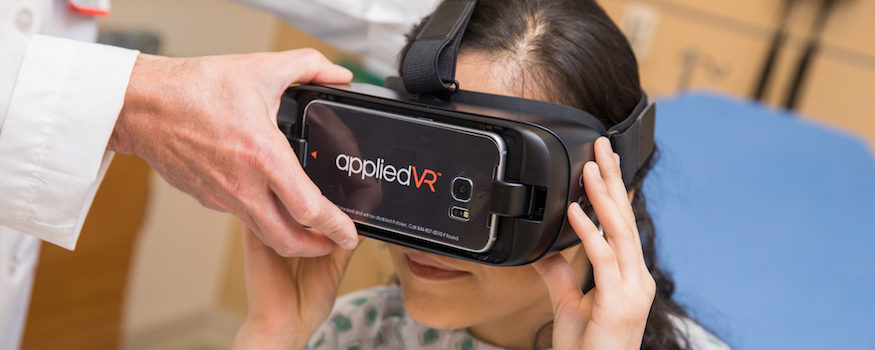The opioid crisis and over-prescription of pain medication has pushed hospitals to seek alternative ways to treat procedural, acute and chronic pain, as well as anxiety. Virtual reality (VR) has proven an effective means of medical pain management, and the healthcare sector has taken note. Many health facilities now look to deploy their own VR programs to address pain management.
How to Start a VR Program for Pain Diversion
VR technology has been around for decades in various forms, but medical virtual reality programs were mostly relegated to research facilities with deep pockets. VR equipment was bulky, expensive and required a direct computer connection. In the past five years, however, technology has overcome those restrictions. Affordable VR headsets that work with smartphones put VR technology within reach of health facilities of any size.
Create a VR Healthcare Pain Management Program
Explore the key drivers of using VR for pain management and get tips for implementation. Download Now
With equipment limitations no longer an issue, the next step for starting a VR program is choosing a good starter project. For a health facility just beginning its VR journey, the ideal projects have low startup costs, create high impact in areas where VR is proven to work, such as anxiety and pain management, and deliver measurable results. These case studies describe successful VR pain and anxiety management projects:
- Inova Mount Vernon Hospital used VR to reduce anxiety and pain in ER patients.
- Cedars-Sinai has patients using their program, which was used to significantly reduce pain in hospitalized patients.
- Buena Vista Surgery Center uses VR for pediatric patients as a non-drug alternative to calm their nerves before surgical procedures.
Choose a Partner for VR Deployment
The team at your health facility may have only passing familiarity with VR equipment and options. You will likely need partners experienced in deploying VR programs. This may include teaming with both hardware and content (software) providers.
Most consumer VR technology isn’t geared toward healthcare applications, which benefits from more specific content and must meet federal regulations. Seek a hardware partner skilled in this sector. This includes the ability to address sanitation and infection control, as well as the ability to lock equipment so patients can’t browse unauthorized websites or download information. The weight of devices and ease of use is another consideration since users may span a wide range of ages and health conditions.
The same is true for content providers. There are special considerations for content used in a medical pain management program. Motion and speed within the program can cause nausea. When VR is used to treat pain, the content must provide constant distraction from procedures or sensaitons. That means it should flow continuously, without stops and starts that would allow the patient to refocus on their pain. Just as with equipment choice, proper content selection is also affected by the age of the population targeted by your project. A pediatric patient group would likely want different content choices than a geriatric group.
Consider Deployment Needs Specific to Healthcare
If your long-term plan is to grow the VR program at your facility, there are several procedures that need to be in place to make the program successful and measurable:
- If you have a goal for your program — such as reducing the use of pain medicines during hospitalization — then you need to educate your team on when and how to gather and report data.
- Unlike some other health equipment, VR devices may be used by patients unsupervised. You will need a plan to track and monitor the equipment to prevent loss or damage. The devices will also need security safeguard to prevent unauthorized use and show only approved content depending on the user’s role.
- As mentioned above, sanitation and infection control between uses will be another concern. Some VR set providers include liners for infection control. You also need to be sure the devices you purchase can withstand the effects of cleaning solutions.
Determine Software/Hardware Needs And Staff Availability
The equipment and content chosen for your program will depend on how your VR project’s goal. Your team may want to manage the program internally rather than opt for a turnkey operation.
To start your own in-hospital program, you’ll need team members to choose software, choose content, educate other team members and patients on device use, and likely play some role in the technical upkeep (software updates and patches) and security of devices.
A turnkey program manages many of these tasks for health facilities. This includes choosing appropriate content, managing updates and patches remotely, and preconfiguring devices before they are used by the health facility. For most hospitals and healthcare users, the choices comes down to the breadth and depth of their staff and how much time can be dedicated to the management of VR projects.
Bringing these considerations directly to IT and medical care staff can help hospitals form plan for successfully implementing VR within the healthcare space — and improving the overall patient experience.
Explore cutting-edge healthcare technology in more depth by checking out our full line of healthcare solutions.








